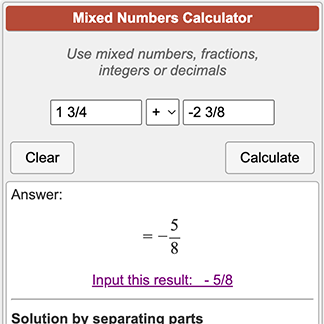
If you need to convert a positive decimal number to a fraction please check out our Decimal To Fraction Converter. In case the ‘Improper’ radio button is chosen you will get your number in the form of improper fraction in the ‘Result’ field. Say, you can enter some mixed number in the field ‘Fraction 1’, then put \(0\) in the field ‘Fraction 2’ and choose the ‘+ (Add)’ action. Moreover, you can use our mixed numbers calculator as a mixed numbers converter. One can switch between these options even after the calculation has performed, changing the form of the result representation. The result can be represented in the form of a mixed number or improper fraction, depending on the option chosen with the help of the ‘Mixed’ and ‘Improper’ radio buttons. Mixed fractions are first converted to the improper ones, then the following formulas are employed. Our online mixed fractions calculator uses the well known math formulas to perform four basic arithmetic operations with mixed numbers. It is denoted as the sum of a non-zero integer and a proper fraction (examples: 2 1/3 = 7/3 and -1 2/7 = -9/7. Instead of the improper fractions, mixed fractions (also called mixed numbers) are often used. The fraction is called proper if the numerator is less than the denominator, and improper otherwise.

Note that the numerator and denominator are natural numbers. A common or simple fraction consists of a numerator, displayed above a line (or before a slash), that represents some number of equal parts of a whole, and a non-zero denominator, displayed below that line (or after a slash), that represents the total number of equal parts of a whole.

It is an abstract concept used to indicate amount, length, quantity, etc. Three pieces, which are each a fourth left over.In mathematics, a fraction represents a part of a whole or, generally, any number of equal parts of a whole. And then how many piecesĭo we have left over? Well, we have 3 pieces and each How many wholes? So the number of wholes, or youĬan imagine, the number of whole pies. The 7 and getting the one, you're essentially saying Many wholes do you have? When you're dividing the 4 into Hopefully you understand why it connects. So you have one whole withģ/4 left over, so you end up with 1 and 3/4. Now, what does this represent? Well, I have 4 fourths Now, what does this look like? So all I did is I rewroteħ/4, or 7 one-fourths. Now this is a whole, right? I have 4 one-fourths.

Seven of those mean, so let me copy and paste that. Let's draw literally 7 fourthsĪnd maybe it'll become clear. But why does that make sense? Why does that actually

One time, and then the remainder is 3, so Now, it might seemĪ little bit like voodoo what I just did. So that's the way we justĬonverted it from an improper fraction to a mixed number. Over, and that comes from right over there. One time, so you have one whole here, and then how muchĭo you have left over? Well, you have 3 left We'll think about what it means in a second. In plain- well, let me just do the problem, and then If we're dealing with fourths,Ĥ goes into 7 a total of one time. To- the easiest way I do it is you say, well, youĭivide 4 it 7. Represents as a mixed number, let me write it inĭifferent colors. It and then we're going to think a little bit about To show you a fairly straightforward way of doing


 0 kommentar(er)
0 kommentar(er)
